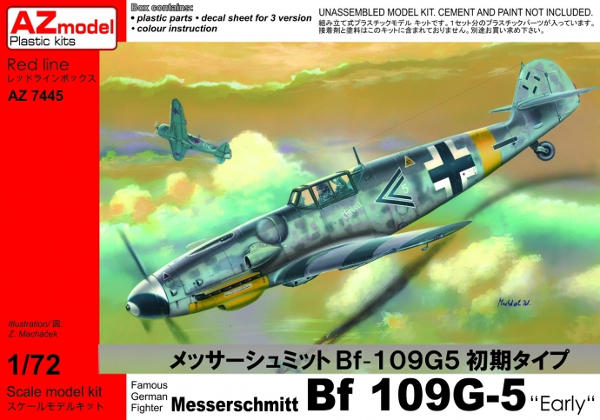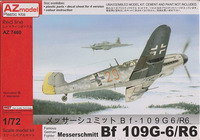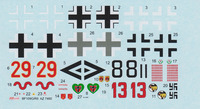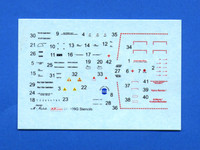
AZ Models 1/72 Bf1 09G-5 "Early" & Bf 109G-6/R6
By Jacob Russell
The Plane
The Messerschmitt Bf109G-5 had upgraded cowling armament, and was equipped with a pair of 13mm MG 131 machine guns in place of the 7.9mm MG 17 guns of earlier variants. The 13mm guns had larger breech blocks and cocking mechanisms. In order to fit them under the cowling two bulges-the so-called "Beules"-were added to the cowling just in front of the windscreen. Another difference was the cowling's gun troughs: these were an insert on the cowlings of earlier Gustavs and a straight press fit, mounted further back, on the G-5. The G-5 used the G-3's machined wheels, larger tires and tailwheel, with the associated upper wing bulges. It also had a pressurized cockpit with silica gel capsules in the canopy windows. The air scoops just below either side of the windscreen were deleted. Early planes had a long antenna mast and solid metal canopy armor, while Late G-5s had a short antenna mast, armored glass canopy armor, and FuG 16ZY D/F loop. Both Early and Late variants had the lower fuselage antenna for the FuG 25A IFF (Identification Friend/Foe) equipment.The G-6 was nonpressurized and was produced in much greater quantities. It was more widely used and was still in front line service in 1945. Initially the only visual difference between the G-5 and G-6 was the small fresh air intake on either side of the G-6's windscreen. Early G-6s had a tall antenna mast but most were equipped with a short mast, FuG 25A and whip antenna and D/F (Direction/Finder) loop. Tall wooden tails and the Erla Haube clear vision hood, with its associated "Galland Panzer" armored glass canopy armor, were used extensively on the G-6. The most widely used variants were the R-3 with 300 litre drop tank, the R-6 with MG 151/20mm cannons in underwing pods (the so called "Kanonenboote"), and the R-2 reconnaisance fighter with the Rb 50/30 camera installation.
Some G-6 aircraft, like the G-5, were fitted with the DB 605AS (S for "Sonder": high altitude flight) engine. It had an enlarged supercharger with a larger engine bearer mount that necessitated a larger cowling with asymmetrical bulges. The new cowling eliminated the need for the "Beules" (bumps) of non 605AS equipped aircraft.
The Kits
Both kits are packed in a sturdy end opening box with colorful artwork featuring one of the better known planes, that of Gerhard Barkhorn, Gruppenkommander of II/JG52 and the second highest scoring ace of World War Two.
The G-6/R6 kit is similarly packaged and the box features the interesting "Red 29" from I./JG 302. The kits consist of 75 parts each, two of which are clear, mounted on three sprues.
The surface detail is extremely well done, and the cockpit is the best of any 109 kit that I have seen in 1/72nd scale, Fine Molds included. AZ plans to produce an entire line of 109G and K variants and the large number of "extra parts" cater to later variants. These extra parts include large main wheels and separate upper wing bulges, two different upper cowlings, three different tail wheels, short and tall tails, drop tank, etc. You can build a G-5, G-6, or G-14 right out the box, and that is pretty cool. I am a stickler for accurate wheels and the AZ wheels, both narrow and wide, are great. The tail wheels, all three of them, in particular are superb. You'll be left with lots of spare parts for the parts box! The holes in the landing gear bays are opened up, another first in this scale, and the upper wing bulges are well molded to the underside of the upper wings. You will have to remove a "false" panel line if you opt for the tall tail, and fill panel lines on either side of the upper cowl because the lines left on either fuselage half when you attach it don't appear on the 1:1 plane.There are three decal options in the G-5 kit, all of which are in, wait for it, the exciting RLM 74/75/76 camouflage:
"Yellow 1", unknown Werknummer and unit, Germany, 1943. Black spinner and RLM 04 yellow rudder and lower cowl."Double Chevron 5", unknown Werknummer, II/JG52, flown by Gerhard Barkhorn, Khakov, Eastern Front, 1943. Black spinner with white spiral, RLM 04 yellow lower wing tips, lower cowl and fuselage band.
"Green 1", Werknummer 15915, JG50, flown by Herman Graf, Wiesbaden-Erbenheim airfield, Germany, 1943. Red spinner, white tail, and RLM 04 lower cowl.
For the Bf 109G-6/R6 kit, you get four options. Like the G-5, these are all finished in RLM 74/75/76 camouflage, but they have some interesting variations:"Red 29", unknown Werknummer, I./JG 302, Helsinki-Malmi, Finland, March, 1944. Split black/RLM 76 undersides and temporary white camouflage on upper surfaces.
"Double Chevron", unknown Werknummer, Stab I./JG 27, flown by Gruppencommander Ludwig Franzisket, Fels am Wagram, Austria, May 1944. Black spinner, white rudder, RLM 04 lower cowl, and green Defense of the Reich band.
"Black 8", Werknummer 26048, 8./JG 54, flown by Gunter Sahl, Luneburg, Germany, Spring 1944. Black spinner with white spiral, RLM 04 rudder and lower cowl, blue Defense of the Reich Band.
"Red 13", unknown Werknummer, 11./JG 27, flown by Heinrich Bartels, Kalamaki Airfield, Autumn 1943. Black spinner, white rudder with scoreboard, and RLM 04 lower cowl.
The decals are well printed, legible and in-register. There is a separate sheet of stencils and a separate placement sheet for them. The instructions are in clear picture format, a la Eduard, and are well illustrated with a logical construction sequence. The kit comes in a clear plastic bag with a self adhesive flap, which completes the impression of a first class presentation. Well done, AZ!Accuracy
There has been a LOT of commentary, much of it negative, on the Internet, about the accuracy of this kit. Respected modeler Barry Numerick, on the 1/72nd Scale Plane Forum, has pointed out that the forward nose is not deep enough, at the junction of the wingroot and fuselge, so a spacer made of sheet plastic is called for to bring the nose up to the proper height. There are also compaints that the canopy maybe too narrow relative to the fuselage.
I checked the fuselage and wings against the plans in Last of the Eagles, and they are very close in length, width, etc. It certainly looks the part!
Conclusion
The AZ Bf109 kits enter a crowded field. The Hasegawa and Academy G kits are widely available but less accurate. The Fine Molds kits are the gold standard in accuracy and fit, but they are expensive and can be hard to find. The AZ kits have a MUCH better interior, and the nose problem can be easily corrected, if it bothers you.
I like the AZ kits. They are well detailed, reasonably accurate, and I think you will be happy with the finished product. I would like to thank AZ Model for providing the review samples.
References
Messerschmitt Bf109 in action Part 2, by John Beaman, Squadron/Signal Publications, 1983
The Last of the Eagles, A Scale Modeler's Guide To The Messerschmitt Bf109G And K, by John Beaman, 1976
Messerschmitt Bf109G/K Vol.1, by Jakub Plewka, Kagero Publications, 2005






